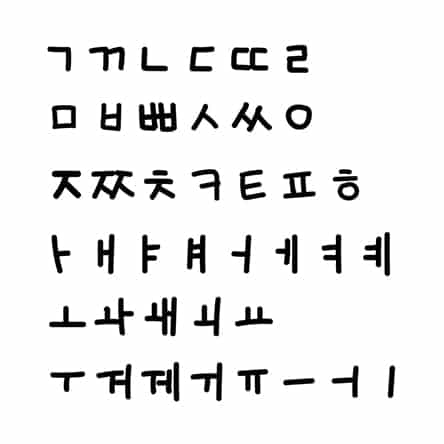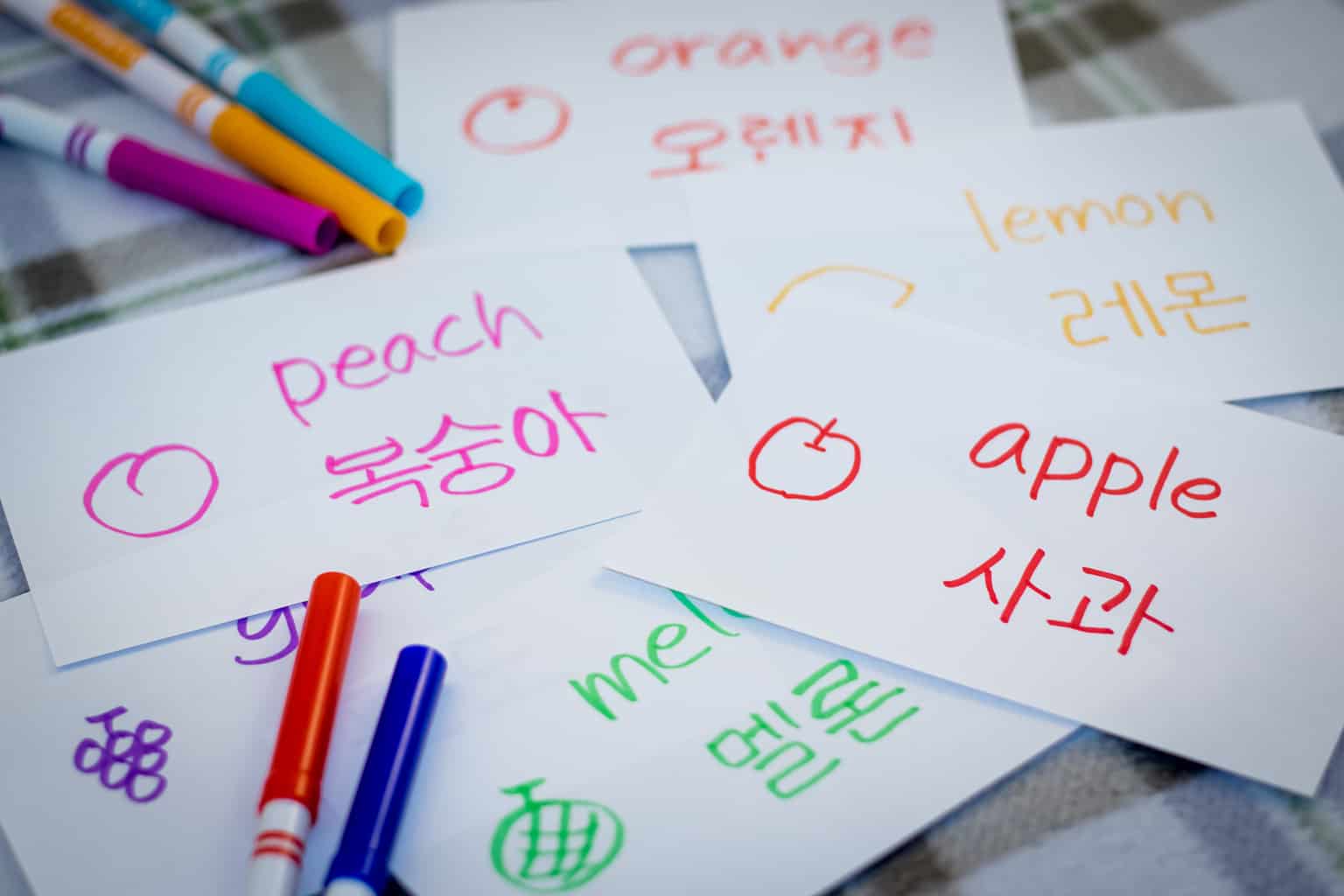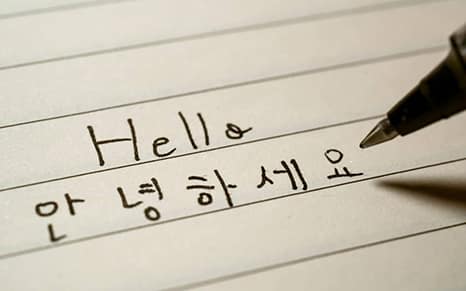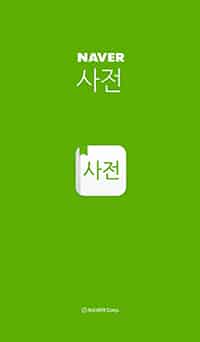If you want to learn Korean, then we’ve got you covered!
This guide is going to give Korean learners like you a brief overview of everything you need to know about how to learn Korean. Just follow each section, pick the language learning parts you want to focus on, and go as deep as you’d like.
Below, we’ve listed all of the resources for learning the Korean language in order of importance. Start at the top and work your way down.
If you would like to take this guide with you and study Korean on the go, we’ve got you covered! The PDF guide download is right here:
Contents
- 1 How to Learn Korean
- 2 How to start learning Korean
- 3 How to Speak Korean for Beginners
- 4 Korean for Beginners
- 4.1 Section 1: The Korean Alphabet (Hangeul)
- 4.2 Section 2: How to Read Korean
- 4.3 Section 3: Korean Pronunciation
- 4.4 How to Speak Korean
- 4.5 Section 4: Korean Numbers
- 4.6 Section 5: Korean Vocabulary Words
- 4.7 How to Remember Korean Words
- 4.8 Section 6: Korean Phrases
- 4.9 Section 7: Korean Grammar
- 4.10 Section 8: Korean Conjugation
- 4.11 Section 9: Korean Honorifics
- 4.12 Section 10: Konglish: Magical Korean Words
- 5 Korean Tutorial
- 6 Korean Tutors
- 7 Korean Language & Dialects
- 8 How to Study Korean
- 9 Typing in Korean
- 10 Get a Korean Name
- 11 Learn Korean PDF
- 12 Wrap Up
How to Learn Korean
This guide has everything language learners like you need to learn Korean. In each section, we provide lessons on reading, writing, speaking, vocabulary, and pronunciation that you can use to study Korean. It will help if you follow the lessons in this language-learning guide in order. However, if you have already started learning Korean, feel free to skip any parts of the online lessons that you already know.
The only part we recommend not skipping is learning Hangeul (the Korean Alphabet). It’s easy to learn, and once you master the Korean alphabet, you’ll supercharge your language learning speed.
Once you’ve got that down, skip to the sections of free Korean lessons you want to focus your learning on the most or go in order. It’s your language journey, so study each part as you like and have fun with it. ^^
What is the best way to learn Korean?
The best way to learn Korean is to do a bit each day. For example, studying Korean for 20 minutes a day is much better than studying once a week for 2 hours. Find a pace that’s comfortable for you, and make sure you’re having fun with it!
How to start learning Korean
There are a lot of fun ways to start learning Korean, depending on your goals.
Most often than not, Korean learners start learning the language by knowing how to read and write Hangul or the Korean alphabet. This is the first lesson that will greatly help you progress with the language.
If your goal is to be able to speak Korean, you can start learning Korean by building your vocabulary through Korean dramas, Korean movies, or even K-pop songs. There are plenty of Korean movie options for learning Korean. The same goes for K-dramas and Korean songs.
To bring your Korean skills to the next level, just identify your goals for the language so you don’t have to learn the things you won’t use.
How to Speak Korean for Beginners
As a beginner in Korean, you need to learn the Korean alphabet first to take to speak Korean. It will greatly help you in correctly pronouncing and understanding Korean words.
After you learn the Korean alphabet, you can get into the habit of learning Korean words next. You can speak better with native speakers and improve your ability to speak Korean.
On top of that, it will come in handy if you have access to resources that offer structured Korean lessons. Ideally, these should include vocabulary and grammar lessons, and practical speaking exercises.
If you focus on these foundational aspects first, you’ll find yourself speaking Korean more confidently.
Korean for Beginners
Korean for beginners can be daunting because of the fact that there’s a new alphabet that’s involved in the learning process. However, this shouldn’t hinder you from learning it.
In each section of this guide, we provide online lessons on the main topics of the language. First, do the primary lessons. Once you are comfortable with the main lessons, you may want to consider studying the related lessons. The related lessons will be helpful but are unnecessary to move on to the next section.
Follow the Korean lessons below and work on making consistent progress with the language.
Section 1: The Korean Alphabet (Hangeul)
Lesson: https://www.90daykorean.com/how-to-learn-the-korean-alphabet/
The first thing you’ll want to do is learn the alphabet. The Korean Alphabet (한글 | Hangeul) is one of the simplest alphabets to learn, even if you are an absolute beginner.
This is probably the most critical step for making any progress in learning the Korean language. Spend 90 minutes learning to read the alphabet or the Korean writing system, and you’ll learn the Korean language quite quickly.
This will also help you learn to speak in Korean since the pronunciation of Hangeul is much more precise than the romanized version [한글 (hangeul) vs. Hangeul, for instance] using the English language.
Related Lesson: Korean Double Consonants
Section 2: How to Read Korean
Lesson: https://www.90daykorean.com/how-to-learn-the-korean-alphabet/#reading-korean-words
After you learn the Korean alphabet, you will need to know how to read Korean. Knowing how to read will make it easier to speak in Korean. Reading aloud will help you with your pronunciation.
Learning to read is fairly simple because words in Korean are broken up into syllables that are 2-4 letters each. Every syllable needs at least one consonant and one vowel.
The letters are read in order, left to right and top to bottom. You can learn how to read Hangul by following the lesson in this section. There are some examples to practice your reading skills as well.
Spend some time reading some simple words, such as Korean slang or the colors in the Korean language. This will be great practice to enhance your reading skills and will help you become more familiar with the words you see on a regular basis.
With frequent practice, you’ll find it easier to speak Korean words and phrases, and soon you’ll be reading Korean wherever you go! You’ll even be able to read the lyrics of your favorite Korean music or song.
Related Lessons: Korean Slang, Colors in Korean
Section 3: Korean Pronunciation
Lesson: https://www.90daykorean.com/korean-pronunciation/
Another important part of learning Korean is the Korean pronunciation. You’ll need to know how to correctly pronounce the letters and words. Improper pronunciation is a mistake that many Korean learners make. Instead, focus on sounding like a native Korean speaker.
In order to have good Korean pronunciation, there are rules that you need to keep in mind as you study and practice pronunciation.
First, the Korean letters are unique, and each letter has its own sound. Second, the English letters associated with them are just a close approximation of the letters’ sounds. This will bring us back to how important it is to study Korean letters.
Just follow the Korean pronunciation rules in the lesson above, and you’ll have a strong foundation.
How to Speak Korean
Lesson: https://www.90daykorean.com/speak-korean/
Once you know how to read Korean, you’re going to want to begin speaking the language as quickly as possible. That will help you to practice pronunciation and start to have simple conversations.
The good news about learning the language is that you can start speaking Korean and have conversations knowing only single words!
That’s right, once you learn the basic verb conjugation (change the verb form), you can ask questions and answer them. It’s an easy way to get some simple practice with speaking right away. Below is one of our most popular Korean lessons to learn how to make 32 sentences in no time at all. Use it for writing and speaking Korean. We’ll cover the grammar part of that lesson later.
Related Lessons: Korean Sentence Structure
Section 4: Korean Numbers
Lesson: https://www.90daykorean.com/korean-numbers/
Korean numbers are basic building blocks for the language that you should learn early on. They’re a key part of learning Korean.
There are two numbering systems to learn in Korean. They are called the China System (Sino-Korean) and the Korea System (Native Korean).
The China System is very structured, so you can learn to count to a billion by learning less than 20 new words.
Pretty cool, right?
The Korea System takes a bit more time to learn, so we recommend starting with the China System first. You can use this system when you first start to learn Korean. You can learn about the Korea System later.
We’ve got a complete Korean numbers guide in this section, so head there if you want to level up your number skills. For now, here are the numbers 1- 10:
| Numeral | China System (Sino-Korean) | Korea System (Native Korean) |
|---|---|---|
| 1 | ||
| 2 | ||
| 3 | ||
| 4 | ||
| 5 | ||
| 6 | ||
| 7 | ||
| 8 | ||
| 9 | ||
| 10 |
Once you learn the Korean numbers, check out the lessons below. They will help you with telling time in Korean. The related lessons will also help with saying Korean dates and months.
Related Lessons: Telling Time in Korean, Months in Korean
Section 5: Korean Vocabulary Words
Lesson: https://www.90daykorean.com/korean-words/
As you learn Korean, you’re definitely going to want to level up your Korean language skills in vocabulary. The lesson above should help since it gives you a list of the most common words in the Korean language. Learn the Korean vocabulary words first.
Once you get the basic words down, you can move on to other common vocabulary word lists, such as body parts, animals, fruit & vegetables. There are lessons on those topics below. Having a strong vocabulary base will help you understand more about what you hear in conversations.
Related Lessons: Parts of the Body in Korean, Animals in Korean, Fruits & Vegetables in Korean, Thank you in Korean
How to Remember Korean Words
Lesson: https://www.90daykorean.com/how-to-remember-korean-words/
If your native language is English, it can be challenging to learn Korean because there isn’t a great deal of overlap with words (besides Konglish).
However, there are some great strategies that can help you learn new words quickly. One strategy on how to remember Korean words is to use associations, mnemonics, and stories for the words. For example, the word for “house” in Korean is 집 (jip). The words “house” and “jip” sound very different from each other. However, the Korean word “jip” sounds like “Jeep,” so you can make a story using imagery about it.
If you like this method, check out our lesson above called How to Remember Korean Words Easily. Lots of useful tips for learning and memorizing new words.
The more vocabulary words you know, the faster you’ll be able to learn Korean and put your skills to use in everyday situations. We recommend learning 2 – 20 new words each day and using an SRS system like Anki. Keep in mind that the more new words you add, the more reviews you’ll have to do each day.
Section 6: Korean Phrases
Lesson: https://www.90daykorean.com/korean-phrases/
If you want to learn Korean quickly, then it’s good to study the phrases in the lesson above first. These are expressions that you’re going to hear all the time, so it’s easy to become familiar with them.
Then, as you continue to learn Korean and develop your skills, you’ll be able to break down these Korean phrases and understand what native speakers of the language are saying.
| English | 한국어 (Korean) |
|---|---|
| Thank You | (gomapseumnida) |
| Don’t mention it | (cheonmaneyo) |
| Sorry | (mianhamnida) |
| That’s OK | (gwaenchanayo) |
| Hello | (annyeonghaseyo?) |
| Excuse me (to get attention) | (jeogiyo) |
| Excuse me (to apologize) | (sillyehamnida) |
| Excuse me (to pass someone) | (jamsimanyo) |
| Hello (on phone) | (yeoboseyo) |
| Good morning | (annyeonghaseyo?) |
| Good evening | (annyeonghaseyo?) |
| Sleep well | (jal jayo) |
| Sweet dreams | (joeun kkum kkwoyo) |
| Goodbye (to person leaving) | (annyeonghi gaseyo) |
| Goodbye (to person staying) | (annyeonghi gyeseyo) |
| Get home safely | (jal gayo) |
| Have a nice day | (joeun haru bonaeseyo) |
| Yes | (ne) |
| No | (aniyo) |
| Maybe | (amado) |
| Just a moment! | (jamkkanmanyo!) |
Related lessons: Survival Korean, Korean Love Phrases, Korean Drama Phrases
Section 7: Korean Grammar
Lesson: https://www.90daykorean.com/korean-grammar/
As you continue to develop your language-learning skills, you’re going to want to start to understand Korean grammar. You don’t need to know it in-depth just yet. Instead, focus on learning the basics of Korean grammar.
The main sentence structure is:
SUBJECT + OBJECT + VERB
The good news is that it’s fairly easy to learn the fundamentals of grammar. Once you begin learning the basic grammar structure of the language, you can up your game and connect your sentences together. You’ll gain confidence in your grammar skills and have bragging rights reserved for those who take the time to come this far with learning the language.
You’ll also want to learn Korean particles, but don’t spend a lot of time on this grammar point at the beginning. Particles are often omitted in speech, so just understand a basic overview of how they work. You can find out more about them and related grammar with the related Korean lessons below.
Related Lessons: Korean Particles, Korean Conjunctions
Section 8: Korean Conjugation
Lesson: https://www.90daykorean.com/korean-conjugation/
When learning the Korean language, you’re going to want to know how to use verbs and adjectives. You can’t use a verb in its base form, so you need to change the ending so it makes sense in a sentence.
Korean conjugations determine the tense and tone of a sentence. For example, let’s take the verb 하다 (hada), which is in its base form. Here are some sample conjugations:
하다 (hada) – to do
해요 (haeyo) – I do
했어요 (haesseoyo) – I did
할 거예요 (hal geoyeyo) – I will do
Once you know the basic conjugations, you’ll want to learn and improve your vocabulary of Korean verbs.
Section 9: Korean Honorifics
Lesson: https://www.90daykorean.com/korean-honorifics/
As you learn Korean, you’ll often see two different versions of the same words and phrases. Often, one is an honorific version, and the other is the standard version.
Korean honorifics are a way of speaking in Korean that shows your relationship to the other person, the person you’re talking about. They’re important to know when learning Korean because you’ll hear them quite often.
So, for example, let’s say you want to talk about your grandfather. Since he’s higher on the social hierarchy than you, then you’ll want to use honorifics with him. You would use different nouns and different grammar, which would show that he’s on a higher level than you in the social hierarchy.
To demonstrate, let’s say you are learning the word “house.” In Korean, you’d normally say 집 (jip) for “house.”
In the case of your grandfather, you’d use 댁 (daek) instead of 집 (jip) when talking about his house. This could be when you’re talking to him or about him to someone else.
Taking some time to learn Korean honorific words will be worth your while. You don’t need to know them all, but learning a few common ones will help. We’ve got a detailed write-up as well as a list of common Korean honorifics in the lesson.
The honorifics are an integral part of learning Korean and understanding Korean culture. If you want to get to an advanced level, then be sure to become familiar with these as you learn the language. It is best to add them to your Korean learning plan and study them on a regular basis. That way, you’ll be familiar with them when you read about or hear them.
Related Lessons: Korean Titles of Family and People
Section 10: Konglish: Magical Korean Words
Lesson: https://www.90daykorean.com/konglish/
There are a number of words that come from the English language, as well as other languages. They’re also called “loan words,” but we think Konglish sounds more fun (Korean + English = Konglish). When you begin learning words in Korean, make sure you start with these first.
Here’s an example of Konglish:
See how 커피 (keopi) sounds like “coffee”?
You already know more words than you thought! =)
We’ve got the full list of Konglish with audio to help you study. Starting with these words is a great way to learn Korean because they’ll already be familiar to you. Simply read them aloud and see if you can recognize the equivalent word in another language. This is an excellent method for learning Korean that will help you to get speaking and pronunciation practice at the same time!
Related Lessons: Shortened Korean Words
Korean Tutorial
There are several ways to learn Korean, especially nowadays. With the help of technology and the popularity of the Korean language and culture, there are a lot of available Korean tutorial lessons and classes everywhere. There are Korean tutorial lessons and offline and online classes available.
If you’re looking for Korean tutorial lessons and classes, you can start with the free Korean video lessons on YouTube and lessons in blogs. However, to have structured Korean courses that will guide you through learning the language, you can join an online course.
Korean Tutors
If you prefer learning with someone who can guide you one-on-one, you can look for an online Korean tutor. We have a separate article here that will guide you on how to look for the perfect private Korean tutor for you. This can help you consider factors such as schedule, lesson materials, your learning style, and the tutor’s teaching style before you start learning with them. These can be Korean tutors near you, or someone you can contact online.
Korean Language & Dialects
Lesson: https://www.90daykorean.com/korean/
The Korean language is spoken by over 70 million people worldwide. There are different versions of the language for South Korea and North Korea. There are no tones in the language.
There are various dialects for the 사투리 (saturi) 6 regions of the country. 서울말 (seoulmal | Seoul dialect) is the standard, and 제주말 (jejumal | Jeju dialect) is the most unique.
We recommend learning Korean by focusing on lessons that teach the Seoul dialect. It’s the best for language learning when you’re first starting out. All of our online lessons teach the Seoul dialect. Once you have that down, you can branch out and start learning some bonus colloquial words to your repertoire.
Related Lessons: Satoori
How to Study Korean
As you’re learning Korean, you’re going to want to review what you’re learning. Here are some great tools, resources, and skills you’ll want to develop to help you with studying Korean. Learning Korean is easier than you think as long as you have the proper resources!
Apps for Learning Korean
There are a lot of apps for learning Korean, but it’s best to choose the essentials first. Naver Dictionary has an app form, so that’s an excellent one to start using first.
Anki is also a fantastic app for making custom flashcards to help you learn Korean. It’s useful for boosting your Korean vocabulary skills whether you’re at a beginner, intermediate, or advanced level in the language. Getting a solid base of words in Korean will help you learn Korean fast.
KakaoTalk is the main chat app in South Korea. If you want to make Korean friends or learn Korean as you practice typing, then this is the app to use!
Below are the apps you need for living or traveling to South Korea. Knowing how to navigate Korean apps can help you learn the language since you’ll get extra practice with the language.
Related Lessons: Korean Anki, Best Best Apps To Learn Korean
Korean Dictionary
Lesson: https://www.90daykorean.com/korean-dictionary/
If you’re going to learn the Korean language, then you want to use the best Korean dictionary available to help you study.
We’re big fans of Naver Dictionary. It is the most popular free online dictionary for native Koreans when they are learning other languages. They provide the pronunciation for many of the words if you click on the blue speaker near the words. They also provide sample sentences so you can see how the vocabulary word would be used in the context of a sentence.
You can also enter grammar into the search box and get a brief description of how to use it.
Korean Translators
You can use Naver’s Papago for translations, but make proper Korean language education your primary focus. It’s best to use it as a backup as you’re learning the language.
For example, maybe your plan is to learn Korean by translating simple sentences. Although you may not know all of the words in the sentence, you could figure each of them out by typing them into a Korean dictionary (or cut and paste if you can’t type yet). You could use this method of practice to try to understand Instagram or Twitter posts.
Once you get the gist of the sentence, check it using the translator. Keep in mind that the translator may not be 100% accurate, so your understanding of the sentence may actually be correct. This is a practical way to learn Korean, and quite fun, too!
Korean Language Classes
If you’re interested in Korean language classes, we have a structured online Korean course that you can do no matter where you are in the world. If you follow the steps in the course, you will learn Korean fast. In the first 90 days of the course, you’ll learn how to have a 3-minute conversation in Korean. If you want to continue to learn the language at an advanced level, we can help with that, too.
The course is 100% online and structured, which means you can learn Korean at your own pace. Membership includes full access to all of the online Korean lessons in the course, a personal coach to check your work, and a supportive community of Korean language learners like yourself.
You can study Korean courses on your computer, tablet, or mobile device. You get all of the resources you would get in Korean classes with the flexibility to do everything online at your own pace.
Typing in Korean
Lesson: https://www.90daykorean.com/typing-in-korean/
If you know how to type in English without looking at the keyboard, then it’s fairly easy to learn to type in Korean as well. And if you know how to type in Korean, it will help you learn Korean faster. Learning to type in Korean is like getting two lessons at the same time!
There are also other side benefits to learning how to type, such as being able to send text messages in KakaoTalk and searching on Korean websites. Texting with Korean friends over KakaoTalk will help you practice communicating using the Korean language anytime you’re online! You’ll also be able to learn new words and understand more about Korean culture.
You can get a Korean keyboard for your desktop or just get stickers to put over your existing keyboard. If you’re a true typing warrior, try downloading an image of the Korean keyboard layout. Put the keyboard layout nearby, and learn to type by reading different Korean vocabulary and sentences. It’s great typing practice and will help you learn Korean in the process.
It’s a piece of cake to install a keyboard on your smartphone or tablet, just head over to your operating system settings and add one in. Once you do that, study the lessons below to help you get additional practice. You’ll be typing in Korean in no time.
Related Lessons: Korean Texting, Korean Emoticons
Get a Korean Name
Lesson: https://www.90daykorean.com/korean-name/
If you really want to immerse yourself in Korean culture (and get some extra language practice), then make sure you have a Korean name!
Not only will this help you learn the language, but it will help you with making Korean friends. They will be impressed to find that you’ve got a Korean name.
Typically, people get their Korean name by using one of these methods:
-
- Write your name in Korean letters
- Random name generator
- Chose a name from a list
- Find a Korean name that sounds like your name
- Pick a name with a special meaning
- Get a Korean name chosen by professionals
Simple things like getting a Korean name and writing it over and over will help you with learning the Korean language. We’ve got a complete lesson on it above, which will help you find out how to choose your very own Korean name.
Learn Korean PDF
As we listed above, there are a number of basic lessons you need to go through as you learn Korean. However, this shouldn’t overwhelm you or stop you from learning the language.
You can go through the lessons one at a time at your own pace.
How to use the Learn Korean PDF:
- Read the tips and lesson overview in each section carefully.
- Once you’re done with the overview, go through the main lessons given in each section.
- After the main lesson, there are related lessons that you can read to help expand your knowledge of the language.
- You don’t have to follow the lessons in order. You can skip the lessons that you already know.
Before we close this lesson, make sure to keep this resource with you:
Wrap Up
Now that you’ve got a solid base for learning Korean, it’s time to put it into practice! You could start by doing things like trying to understand words from your favorite K-Pop song or K-Drama. If you currently live in South Korea, try speaking Korean as you go about your day.
Or if you feel challenging yourself further, how about trying out some Korean quizzes?
What else do you want to know about learning the Korean language? Let us know in the comments below!












i liked these classes, you helped me a lot, because i had guests from korea, and now i freely communicate with them in korean
Thanks for your comment! ^^ I’m glad that our article has been helpful to you. If you want to know more about the Korean language and culture, you can also check our blog and visit our YouTube channel for articles and videos with great Korean content.
thanks for your big work
Thanks for your kind words, Archy!^^
Hi master the lesson have been interesting and I have truly enjoyed
joeun kkum kkwoyo.
gomapseumnida.
Great, thanks for your comment! I’m glad to know that you’ve enjoyed reading our article. ^^ If you want, you can also check our blog and visit our YouTube channel for articles and videos with great Korean content.
Annyeonghaseyo
Am lawrencia thanks for the free step by step learning you
gave me I can be able to speak Korea a little now
gomapsuebnida
Thanks for sharing, Lawrencia! I’m glad that our article has been useful to you. ^^